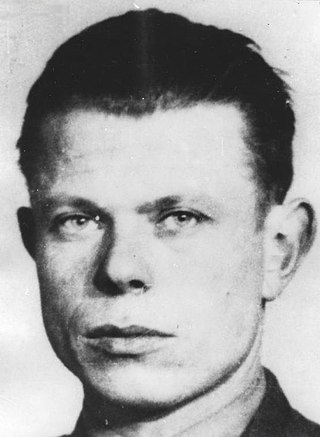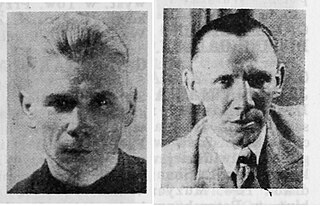
The Voivodeship and Municipal Public Library "Dr. Witold Bełza" in Bydgoszcz is housed in historical buildings located between the Stary Rynek and Długa street, registered on the Kuyavian-Pomeranian Voivodeship Heritage List. It is the oldest (1903) library in activity in the Kuyavian-Pomeranian Voivodeship. Since 2002, it bears the name of Witold Bełza.

The Feliks Nowowiejski Academy of Music is a Polish state music university located in downtown Bydgoszcz. Its origins date back to 1974, as branch of the Music College in Łódź until 1979. At that point it was established as independent Bydgoszcz State College of Music, consisting of four departments. The current name was adopted in 1981.

Farna Street is a street located in Bydgoszcz, Poland. Many of its buildings are either registered on Kuyavian-Pomeranian Voivodeship heritage list, or part of Bydgoszcz local history.

Bydgoszcz Old Market square is an oblong place, situated in the old town district of the city of Bydgoszcz. The City Hall flanks one of its side, and nearby is located St. Martin and St. Nicholas Cathedral.

Seminaryjna street is located between Wilczak, Błonie, Downtown districts in Bydgoszcz, Poland. Laid in the late 1870s, its winding path offer a view on the old town nested down in the Brda river. Many frontages and edifices display architectural and historic interests, one of them is registered on the Kuyavian-Pomeranian Voivodeship Heritage List.

The Leon Wyczółkowski Regional Museum is an ensemble of cultural institutions which have been first created in 1923 in the city of Bydgoszcz, Poland.
Ludwik Regamey (1877-1967) was a Polish construction engineer by trade. He worked in Bydgoszcz where he had a very active associative life as a musician. He was the first chairman of the Alliance Française in Bydgoszcz. After moving to France in 1934, he was a formidable promoter of French and Polish culture exchanges till his demise in 1977, in Toulouse.

Maximilian (Maksymilian) Antoni Piotrowski (1813–1875) was a Polish painter and professor at the Academy of Fine Arts in Kaliningrad. Additionally, he was a Polish patriot who took part in the national uprisings of the time.

Adam Franciszek Józef Siedlecki or Adam Grzymała-Siedlecki (AGS) (1876–1967) was a Polish literary and theater critic, playwright, translator, prose writer and director.

Józef Weyssenhoff was a Polish novelist, poet, literary critic, publisher. Close to the National Democracy political movement after 1905, he paid tribute to the tradition of the Polish landed gentry in the Eastern Borderlands. He lived several years in Bydgoszcz in the 1920s.
Witold Stanisław Kazimierz Bełza was a Polish librarian, writer, publicist and cultural activist. He was the director of the Provincial and Municipal Public Library of Bydgoszcz from 1920 to 1939 and from 1945 to 1952.
Antoni Weynerowski was a Polish entrepreneur, founder in Bydgoszcz of the firm Leo, renamed Kobra, one of the largest shoe manufacture in Poland in the interwar period.

The Pomeranian Leather Factory "Kobra" is a former shoe producing company based in Bydgoszcz. The firm was one of the largest in Poland in its domain. It went bankrupt in 1992. Starting with felt shoes, the company then manufactured leather footwear, mainly for men and for uniformed services; it provided as well production and repair services for the leather industry.

Stanisław Jerzy Sędziak, noms de guerre "Warta", "Wola", "Oset", "Wojna", "S-2", "T", "Stanisław Sędziszewski", "Zaremba", "Kulesza", "Czesław Noakowski" – a certified lieutenant colonel of the Polish Army, participant in the defensive war of Poland in 1939, cichociemny; 1942–1944 chief of staff of the Home Army Nowogródek District, in 1944 acting commander of the district, deputy and then chief of staff of the Białystok Citizens' Home Army District, Delegate of the Armed Forces for the Białystok District, in the years 1945–1947 deputy president of the WiN Central Area Management.

Stanisław Horno-Popławski (1902-1997) was a Russian-Polish painter, sculptor and pedagogue.

Michał Antoni Łempicki (1856-1930) was a mining engineer and entrepreneur. He was a Polish public and political figure, deputy of the State Duma of the Russian Empire for the Piotrków Governorate.

Brothers Teodor and Franciszek Gajewski were sculptors and painters, who lived in Bydgoszcz, Poland in the 20th century.
Polish Socialist Party of Lithuania and Belarus was a left-wing political party, that was an autonomous branch of Polish Socialist Party, and which operated in Lithuania and Belarus in the late 1910s and early 1920s. Its political programme was identical with the one of Polish Socialist Party, and was based around left-wing nationalism and revolutionary socialism.

TG Sokół Sokołów Małopolski is a Polish football club based in Sokołów Małopolski, Poland. The club was established on November 17, 1894. They're currently playing in Klasa Okręgowa.
Witold Abramowicz was a politician and jurist. In 1919, he served as the mayor of Vilnius, Lithuania, and from 12 October 1920 to 16 January 1921, he was the chairperson of the Provisional Governing Commission, an executive government of the Republic of Central Lithuania. In 1922, he was the leader of the Democratic Party, which he represented in the Sejm of Central Lithuania from 1 February to 1 March 1922. From 11 March 1928 to 10 July 1935, he represented the Nonpartisan Bloc for Cooperation with the Government for Vilnius electoral district, in the Senate of Poland.















